What is the shell drill in basketball
The shell drill is a basketball drill that is typically implemented to improve various defensive related concepts in addition to developing better communication between players as well as strengthening overall offensive/defensive basketball skills and intelligence.
The shell drill could also be beneficial for teams that primarily practice and implement a man to man defensive system against their respective opponents.
Which defensive concepts could be potentially enhanced with the shell drill
The shell drill could potentially enhance basketball defensive concepts such as the defensive stance, defensive sliding, on-ball pressure defense, jumping to the ball, and defensive closeouts.
Defensive stance
Before beginning the shell drill, it is necessary to understand the very basics of the defensive stance in the game of basketball.
To execute the proper defensive stance, each defender that is practicing the shell drill should have their feet slightly wider than shoulder width apart, their knees bent, and their back straight while maintaining balance.
Also, defenders should try to remain on the balls of the feet and not stand flat-footed. Moreover, defenders should have their hands up with their arms extended away from their sides.
On-ball pressure defense
Additionally, when executing the shell drill, on-ball defenders should generally be within three feet of the offensive player with the ball to apply an adequate amount of defensive pressure while still maintaining the proper defensive stance.
Moreover, on-ball defenders should have their hands mirror the ball. That is to say, if the ball is high near the offensive player’s chest or above the shoulders, then the hands of the defender should be high as well.
By doing this, the on-ball defender may be able to deflect the ball if the offensive player attempts to pass it to another teammate.
Conversely, if the ball is low near the offensive player’s hip area (i.e. the offensive player is basically in a triple threat position), then the hands of the defender should be low as well.
Also, in that particular instance, if the offensive player is a good perimeter shooter, then the on-ball defender could have one hand near the face of the potential shooter while the other hand is near the ball.
This allows the on-ball defender the opportunity to take away a probable jump shot and at the same time, the defender is in a position to completely stop or at least, slow down any feasible dribble penetration by the offensive player.
In addition to that, it is important to note that an on-ball defender should not reach in aggressively in an attempt to steal the basketball from the offensive player. If that occurs, the defender could possibly get called for an unnecessary foul by the referee.
Defensive sliding
After executing the proper stance, shell drill defenders should be prepared to execute the defensive slide in which those same defenders would move their feet laterally from side to side with one foot leading the other.
For example, if a defender wants to move to their right (which would be the left side of the court from the offensive team’s point of view), then the defender should move laterally (from side to side) with the right foot leading first followed by the left foot thereafter.
Conversely, if a defender would like to move to their left (which would be the right side of the court from the offensive team’s point of view), then the defender should move laterally (from side to side) with the left foot leading first followed by the right foot afterwards.
Also, it is important to note that a defender should try to keep their feet as close to shoulder width apart as possible while executing the lateral slide. In other words, the defender’s feet should never be too close together as that would take away the defender’s lateral quickness.
Furthermore, it should be mentioned as well that a defender should not cross their feet when executing the lateral slide.
If that were to occur, not only does this eliminate the defender’s ability to effectively slide laterally, but it also could cause the defender to lose balance.
Jump to the ball
Within the execution of the shell drill, if an offensive player with the ball passes it to an adjacent teammate, the shell defender that is currently guarding the offensive player that passed the ball should jump to the ball on the air time of that pass.
By practicing the concept of jumping to the ball within the shell drill, it will emphasize to that same player the importance of preventing any potential face cuts by the player that executed the pass.
In addition to that, the defender will also understand how the concept of jumping to the ball helps to limit any immediate offensive dribble penetration by the player that receives the ball from the initial pass.
Closeout to the ball
During execution of the shell drill, if the ball gets passed to a defender’s assignment, that same defender should closeout the open space between themselves and their assignment that is now in possession of the basketball.
Generally speaking, to execute the defensive closeout, defenders should have a good defensive stance and sprint towards their assignment, particularly with long steps.
Afterwards, defenders should use short choppy steps upon fully closing the space and defenders should also get at least one hand up, typically slightly above the shoulders of their assignment with the ball.
Limit dribble penetration
In certain instances of the shell drill, the offensive players, particularly near the perimeter areas, could try to get dribble penetration towards the basket.
Therefore, in general, the shell defenders, particularly the on-ball defenders as well as the adjacent off-ball defenders to a small degree could attempt to limit that dribble penetration, especially away from the middle of the lane, also referred to as the key.
This is feasible by executing the aforementioned proper defensive stance as well as the movement of the on-ball defender’s feet via the defensive slide technique.
Stunt at the ball
In certain situations within the shell drill, if an offensive player attempts to get dribble penetration against an on-ball defender, then an adjacent off-ball defender could stunt at the ball to limit that dribble penetration.
To stunt at the ball, the adjacent off-ball defender would temporarily step towards the offensive player with the ball, particularly at the moment of the initial dribble penetration, before recovering to the original assignment.
The primary objective of the stunt action in this case is to slow down the dribble penetration of the offensive player with the ball which should give the on-ball defender enough time to recover back in front of that same player with the ball.
Deny the ball
When implementing the shell drill, it is also possible for an off-ball adjacent defender to deny the ball and hinder the offensive player that they are currently guarding one pass away from receiving the ball altogether.
To deny the ball, the adjacent off-ball defender should place the foot that is opposite the ball in the middle of the denied offensive player’s body, usually between the feet of that same offensive player.
Furthermore, the off-ball defender should place the other foot that is closest to the player with the ball slightly above the offensive player that is being denied.
Next, the off-ball defender should place the forearm that is opposite of the player with the ball on the chest of the offensive player that is being denied.
After that, the off-ball defender should have their arm and hand that is closest to the ball fully extended in the passing lane between the offensive player being denied and the player with the ball.
Moreover, the off-ball defender should have the palm of their hand towards the ball. In other words, the defender should be able to see the back of their hand and not their palm.
This basically helps the defender deflect the ball if the offensive player with the ball attempts to pass it to the offensive player being denied.
What are simple examples of a 3 on 3 defensive shell drill
Example 1 – Part 1
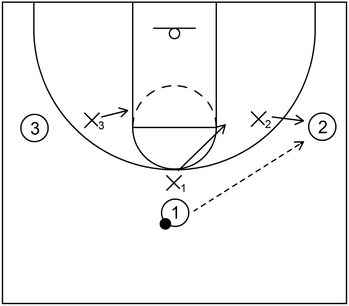
This is an example of a 3 on 3 defensive shell drill that seeks to practice jumping to the ball, defensive sliding, and closeouts.
Offensively, 1 begins with the ball at the top and receives on-ball defensive pressure from X1 while X2 and X3 are about a step away from their respective assignments inside of the three-point line.
Afterwards, 2 receives the ball from 1 and when that occurs, X1 jumps to the ball and X2 performs a closeout to implement on-ball defensive pressure near the right side wing.
Additionally, X3 executes a defensive slide towards the left side of the lane as a weak side help defender that is more than one pass away.
Example 1 – Part 2
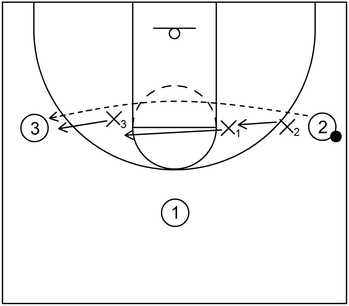
Next, 3 receives the ball via a skip pass from 2. When that happens, X3 executes a defensive closeout on the ball and X1 covers the gap near the left side high post elbow to limit dribble penetration.
Additionally, X2 slides towards the right side of the lane as a weak side help defender.
Example 2
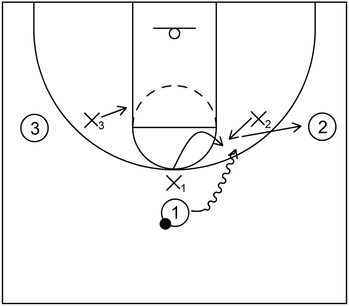
This is an example of the 3 on 3 shell drill in which dribble penetration occurs from the top. To start, 1 attempts to dribble towards the basket. However, X2 is able to hinder the dribble penetration by executing the stunt and recover tactic.
Furthermore, as that happens, X1 sprints to get back in front of the ball while X3 slides towards the left side of the lane as a weak side help defender.
What is a simple example of a 4 on 4 defensive shell drill
Part 1
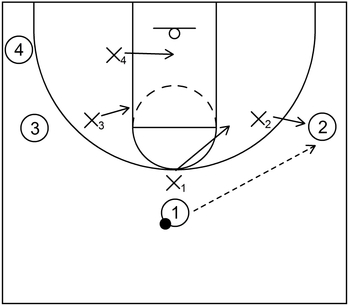
This is a simple example of a 4 on 4 defensive shell drill that implements various on-ball and off-ball defense concepts. To start, X1 applies on-ball defensive pressure at the top against 1.
Following that, 2 receives the ball from 1 and when that happens, X2 performs a defensive closeout to apply on-ball pressure while X1 jumps to the ball near the right side elbow.
Additionally, X3 slides towards the left side of the lane while X4 can slide into the lane for extra basket protection.
Part 2
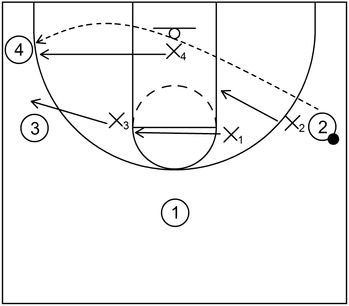
Next, 4 could receive the ball via a skip pass from 2 and when that occurs, X4 follows the pass to closeout near the left side corner.
Moreover, X3 could deny the ball towards the left side wing area while X1 stands in the gap between the left side wing area and the left side high post elbow.
Also, X2 could drop back towards the mid-post near the right side of the lane area as a weak side help defender. This gives X2 the opportunity to mitigate any potential basket cuts by 1 or 2.
What is a simple example of a 5 on 5 defensive shell drill
Part 1
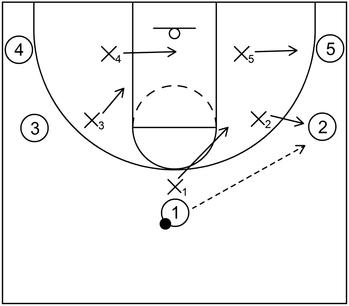
This is a simple example of a 5 on 5 defensive shell drill that seeks to develop a variety of defense concepts on the ball and off the ball. To begin, X1 applies pressure at the top against 1.
After that, 2 receives the ball from 1 and when that happens, X2 performs a defensive closeout while X1 jumps to the ball.
Furthermore, X5 moves a step closer towards the right side corner in anticipation for a possible closeout if 5 were to receive the ball.
On the weak side, X4 could slide into the lane to protect the basket while X3 could drop back towards the mid-post area near the left side of the lane.
Part 2
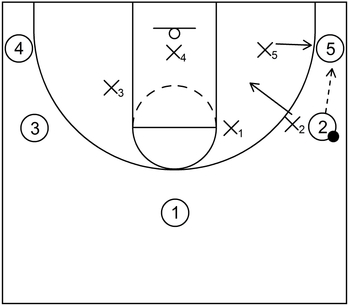
Next, 5 could receive the ball from 2 which triggers a closeout by X5. Additionally, X2 could drop back towards the gap between the right side wing and right side corner to take away middle dribble penetration if necessary.
X1 stays near the right side high post elbow, X3 continues to stand near the mid-post, and X4 continues to protect the basket.
Part 3
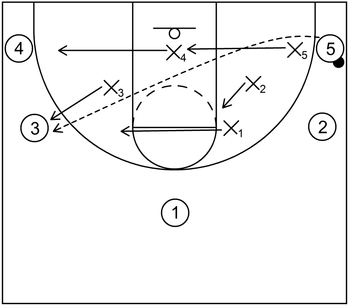
Next, 3 could receive the ball by way of a skip pass from 5. When that occurs, X3 performs a closeout on the ball while X4 sprints from the paint towards the left side corner.
Additionally, X1 covers the left side elbow to take away dribble penetration while X2 slides toward the right side mid-post and X5 sprints into the lane to protect the basket.